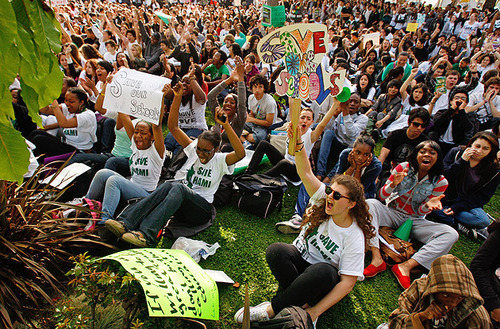 Hamilton High School in Los Angeles’ 2011 student walkout in protest of proposed cuts, teacher layoffs. (Photo: LAT)
Hamilton High School in Los Angeles’ 2011 student walkout in protest of proposed cuts, teacher layoffs. (Photo: LAT)
The Necessity of High School Organizing
By Kathryn Seidewitz
I just graduated from high school. I was a high school activist. Actually, I was an activist in high school. I think the distinction is important to make. Although I attended many protests, hung out with anarchists, and spent a fair bit of time traveling around and writing about student organizing, I never actually did any real organizing within my own community – namely, the people I went to school with. The protests I attended were organized for and by adults, the anarchists I hung around were mainly concerned with things like the environment and home foreclosures, and the student organizing I wrote about was mostly done by college students.
I grew up in Prince George (PG)’s County, Maryland. It borders Washington, D.C. and has been called “Ward 9,” a reference to DC’s 8 wards. In a state that has been ranked number one in education time and time again, PG County has some of the worst, underperforming schools in the state.
My sister, Tess, started elementary school in the mid-90s, when desegregation practices were still in place. As the only white girl in her classrooms, she could have her pick of magnet schools with “talented and gifted” programs. Even the best of these schools couldn’t stop Tess from hiding under desks and disrupting classes out of boredom (or perhaps it was her ADD, diagnosed much later, something not a single school was equipped to handle). Even after her skipping a grade, nothing worked. So, as I was about to enter preschool myself, my parents pulled Tess out of public school and placed us both in a Montessori school.
Tess returned to PG County public schools in high school, when she attended Eleanor Roosevelt High School, the single school in the county that performs at or above Maryland average. Even there, she was subject to the intense standardization and rigorous rules that governed every aspect of the student’s lives. (My favorite story: if girls broke the dress code they were required to wear a hideous, large yellow t-shirt, which, my sister gleefully recounted, became a fashion statement.) It was from Tess’ experiences that I learned what public school was: unyielding and strict.
Meanwhile, I attended a small private high school one county over, where people looked at me like I had cancer when I told them where I was from. They were kind to us there, listened to our problems, and went out of their way to make sure each and every person in my class graduated. There were special programs for kids with learning differences and support programs for those with organizational issues. One hundred per cent of my graduating class went to college.
It wasn’t until I was nearly finished with high school that I began seriously paying attention to students who organized within their high schools. In my own county, high schoolers had staged a walkout at Northwestern High School in March 2012. In New York and Philadelphia, students were walking out of schools. On the West Coast, students and teachers in Seattle and Portland were boycotting standardized tests.
Where was I in all of this? I was a spectator. Because even though I was deeply entrenched in radical communities in DC, I saw no avenue in which to engage my peers in the struggle. The high schoolers that had begun to organize in their schools had done so by either creating their own avenues (like El Cambio, which was formed in the 2011-2012 school year and planned the Northwestern walk out) or playing off of already established organizations (like the Philadelphia Student Union).
I think this is the biggest reason why high schoolers, for the most part, don’t organize. They are disenfranchised at every turn. They have all their power and autonomy stripped from them - through their schools which don’t trust them to even be in the hallways unmonitored to some parents who place strict social controls on their teenagers. If they do find their way into organizing communities, a space isn’t carved out for them, they must force their way into it. They do this, not by focusing on their own issues, but the issues that are offered to them. When I joined Occupy DC, there was plenty of space to talk about DC statehood, gentrification, and local politics. There was a complete wall, however, between occupiers and high schoolers. There were some flimsy attempts to speak at high schools, mostly initiated by the handful of high schoolers who were there, but for the most part our issues weren’t even considered. We were, after all, the extreme minority. There is no space for high school organizing in adult activist communities.
At Northwestern High School in Hyattsville, Md., where my friend, Shane, and another recent high school graduate, helped organize a walkout in his junior year, students had to create their own space. They formed El Cambio, and began holding weekly meetings which culminated in a walkout in March 2012. After the walkout, El Cambio continued to hold protests, events, and discussions on race, gender, and politics. Shane and his friends had to build El Cambio from the ground up. They were lucky enough to have a single teacher in the International Socialist Organization who could provide them with support, organizational tools and resources that they wouldn’t have otherwise had.
“I think kids really are an oppressed group,” Shane told me. It may sound like an exaggeration, but it’s true. Teenagers are subject to strict schedules, are routinely told their ideas are worthless, are called lazy, and are belittled for their interests. Teenagers must navigate the complicated pressures of relationships, school work, and sexuality without being given any of the proper tools or resources. Instead, they are bombarded with confusing messages and rigorous rules and restrictions.
The only way to combat this is to do what the kids at Northwestern High School did – create their own spaces to organize and discuss. If you weren’t a high school organizer, half of college organizing is unlearning the practices of disempowerment high school students are trained with. Hand in hand with that, there need to be adults within the radical community intent on facilitating and helping create those spaces. Teenagers are intentionally isolated, are told their world is a bubble, that high school isn’t “real life,” and that, if they want to create any real change, they have to wait until they are adults and can make real decisions. It isn’t particularly surprising that they’re “apathetic” and uninterested in activism.
This is where real change needs to be made. These paradigms must be actively challenged and remolded while we’re still in high school. Besides a few important exceptions, like Shane’s teacher at Northwestern, this is not happening in schools. But, it isn’t happening enough in other places, either.
When I joined the radical world, there was no space for my problems as a high schooler - there was no space to talk about the politics of sexual education, the bullshit propaganda of my history class, or even help when I waged a private war against the administration and our school uniform (it wouldn’t be until the last month of my senior year that I finally organized my friends in a protest against it). In an effort to fit into that new world, I isolated myself from my peers and closed off any avenues to organize them.
Activist organizations and communities have to create intentional spaces for young people and then work hard to fill and expand those spaces. This means outreach to schools and youth organizations. Adults, in order to help, should listen to teenager’s issues and offer them the organizational tools and support to allow them to get what they need.
“What I took away from high school was that we can’t be afraid to create those spaces,” Shane said. “I had kids tell me that high school wouldn’t have been the same without El Cambio. We need more El Cambios.”
Follow Kathryn on Twitter @Rynseid.
Kathryn Seidewitz
un-ironically saying yolo since 2012.
Catch up with me @rynseid.

